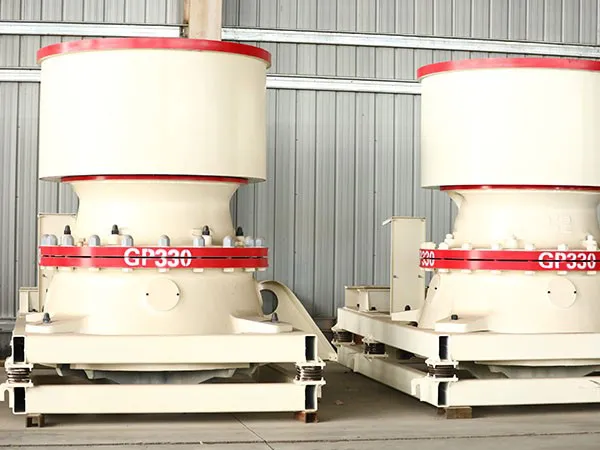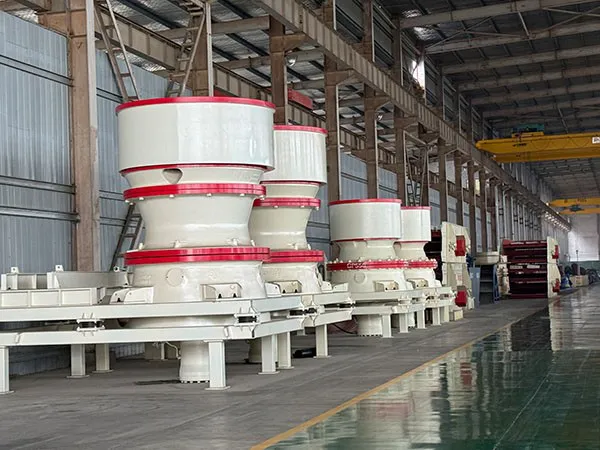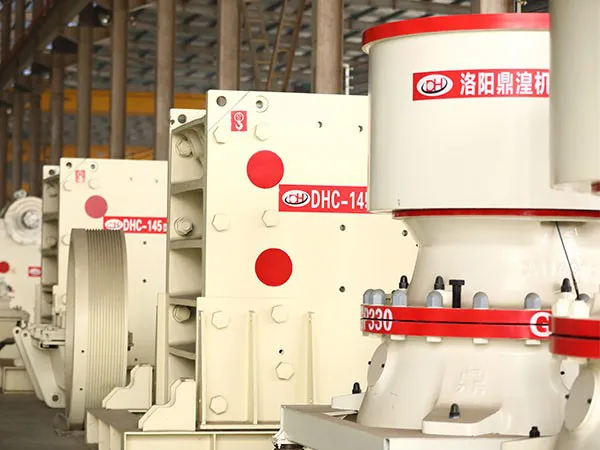Excessive wear of a cone crusher is a common issue that can lead to reduced efficiency, increased downtime, and higher operational costs. Troubleshooting it involves systematically examining various aspects of the crusher's operation and maintenance.

Different wear patterns can indicate different underlying problems. Observe where the wear is most prominent:
Even wear across liners: This might suggest normal operation but still points to a need to optimize settings or consider different liner materials for extended life.
Localized wear (e.g., top, middle, or bottom of liners):
Top wear (near feed opening): Often due to oversized feed, bridging of material, or an uneven feed distribution where larger material impacts the upper part of the chamber.
Bottom wear (near closed side setting - CSS): Can be caused by too small a feed size, where most crushing occurs at the bottom, or an incorrect CSS for the material.
Uneven wear on one side: Indicates segregated feed (material biased to one side), poor alignment, or issues with the eccentric throw.
Wear on non-liner components (e.g., bevel gears, bearings, main frame): This suggests more severe mechanical issues, lubrication problems, or foreign objects.

Incorrect operational settings are a primary cause of premature wear.
Closed Side Setting (CSS):
Too tight: Increases crushing forces, leading to high stress on liners and potentially overloading the crusher. It can also cause excessive fines and increased power consumption.
Too wide: Reduces the reduction ratio and can lead to inefficient crushing, poor product shape, and uneven wear as material "slips" rather than being crushed.
Adjustment: Ensure the CSS is correctly set for the desired product size and material characteristics. Regularly check and adjust it as liners wear.
Feed Material:
Abrasiveness and Hardness: Highly abrasive materials naturally cause more wear. If possible, use wear parts made of materials (e.g., high-chrome cast iron, martensitic steel, high carbon alloy steels) suitable for the material's properties.
Feed Size:
Oversized feed: Causes increased impact on the upper part of the liners and can lead to bridging, reducing throughput and increasing wear. Ensure upstream screening is effective.
Too small feed: Concentrates crushing action at the bottom of the chamber, causing accelerated wear there.
Poorly graded feed: A wide range of feed sizes can lead to inefficient crushing and uneven wear.
Moisture and Clay Content: Can cause material to stick, leading to buildup, reduced throughput, and uneven wear. Consider liners with smoother profiles or anti-stick coatings.
Tramp Material (uncrushables): Metal or other foreign objects can cause severe damage and sudden wear. Ensure proper use of magnets and metal detectors upstream.
Feed Distribution:
Segregated feed: When larger or smaller material consistently enters one side of the crusher, it leads to uneven wear on the liners and can cause "ring bounce" (mantle jumping). Ensure the feeder (e.g., belt feeder, vibrating feeder) delivers a consistent, even feed across the crushing chamber.
Choke feeding: Many cone crushers are designed for "choke feed," meaning the crushing chamber is kept full. This promotes inter-particle crushing, which can reduce liner wear and improve product shape. However, overfeeding can lead to overloading.
Crusher Speed and Stroke:
Speed: Impacts crushing force and reduction ratio. Higher speeds generally increase throughput but can also increase wear. Optimal speed balances efficiency and wear.
Stroke: A longer stroke allows for greater material reduction but can reduce throughput for finer products. Adjusting stroke can impact wear patterns.

Thorough inspection of the crusher's mechanical parts is crucial.
Liner Condition:
Wear life: Liners should be replaced before they are worn through, typically when about 50% of their weight is consumed. Operating with excessively worn liners can damage the crusher's underlying components (head, bowl seat).
Cracks or damage: Indicates impact, fatigue, or improper installation.
Liner Installation: Improper installation (e.g., incorrect torquing of bolts, uneven tightening, using expired backing compound) can lead to uneven stress distribution and premature failure. Always follow manufacturer's specifications.
Lubrication System:
Oil Quality and Quantity: Poor quality, insufficient, or contaminated oil (with dust, water, or mud) drastically increases friction and wear on gears, bearings, and bushings.
Oil Temperature: High oil temperature indicates issues with cooling (clogged cooler fins, low water pressure), incorrect oil viscosity, or excessive friction within the crusher.
Oil Pressure: Low oil pressure means inadequate lubrication, leading to rapid wear of critical components like bearings.
Leaks: Oil leaks indicate potential entry points for contaminants like dust and water, compromising lubrication.
Maintenance: Regularly check oil levels, change oil and filters at recommended intervals, and clean cooling systems.
Gears (Bevel Gears):
Meshing: Improper meshing of bevel gears (e.g., due to loose equipment, incorrect assembly) causes increased friction, impact, and rapid wear or even tooth breakage. Ensure proper alignment and meshing.
Material: Ensure suitable, wear-resistant gear materials are used.
Impurities: Foreign objects entering the gear system will cause significant damage.
Bearings and Bushings: Worn, damaged, or poorly lubricated bearings and bushings lead to increased friction, vibration, and component failure. Check for excessive play or unusual noise.
Mainframe and Fastening Bolts: Loose bolts, connectors, or a damaged mainframe can lead to increased vibration, misalignment, and accelerated wear. Regularly check and tighten all critical bolts.
Dust Seals: Damaged or ineffective dust seals allow abrasive dust and impurities to enter the crusher's internal components, leading to rapid wear of bearings, bushings, and the lubrication system. Inspect and replace seals as needed.
Changes in performance can be an early indicator of excessive wear.
Production Level/Throughput: A significant drop (e.g., 10% or more) can indicate worn liners or other issues affecting crushing efficiency.
Product Size Distribution: An increase in the output size of material (coarser product) often signals worn liners or an incorrect CSS. Excessive fines production can also indicate wear or incorrect settings.
Vibration and Noise: Increased or unusual vibrations and knocking sounds can be caused by loose components, worn parts, poor lubrication, or blockages from uncrushable materials.
Power Consumption/Motor Amps: Excessive or fluctuating power draw can indicate overloading, worn components, or inefficient crushing.
Proactive maintenance is key to preventing excessive wear.
Regular Inspections: Daily, weekly, and monthly checks of the crusher, including oil levels, pressures, temperatures, liner condition, and general cleanliness.
Lubrication Management: Adhere to manufacturer's recommendations for oil type, change intervals, and filter replacement. Ensure the lubrication system is clean and free of leaks.
Liner Management:
Timely Replacement: Change liners before they are fully worn to avoid damage to the crusher's structural components. Keep records of liner wear.
Correct Profile Selection: Choose liner profiles (standard, medium, short-head) that match the specific material properties and desired product.
Proper Installation: Ensure correct installation procedures are followed, including proper torquing of bolts and use of appropriate backing compound.
Optimizing Feed:
Pre-screening: Implement effective screening processes upstream to remove oversized material and control the feed gradation.
Feed Regulation: Use feeders to ensure a steady, consistent, and choke-fed material flow into the crushing chamber.
Tramp Iron Removal: Use magnets and metal detectors to prevent uncrushable objects from entering the crusher.
Automated Monitoring Systems: Utilize automation and sensor data (motor current, vibration, temperature, pressure) to monitor crusher health in real-time and alert operators to potential issues before they become critical. Some systems can even compensate for liner wear automatically.
Operator Training: Ensure operators are well-trained in proper crusher operation, daily checks, and recognizing signs of problems.
Quality Spare Parts: Use genuine or high-quality replacement parts to ensure proper fit, performance, and durability.
By systematically addressing these points, you can effectively troubleshoot and mitigate excessive wear in your cone crusher, extending its lifespan and maximizing its efficiency.
How Jaw Crushers Boost Efficiency in Modern Stone Crushing Plants
2025-12-11 08:03Jaw Crusher Selection Guide: How to Precisely Select a Jaw Crusher for Different Working Conditions
2025-12-05 06:38Advanced Eco-Friendly Impact Crushers: Optimizing Industrial Efficiency and Sustainability
2025-11-24 02:27Impact Crusher vs Jaw Crusher: Key Differences, Applications & Efficiency Guide
2025-11-19 03:12Address: Luoyang Luoxin Industrial Park, Henan,China
E-mail: sales@yd-crusher.com
Phone: 86-139-3993-0123

Yude
Mechanical
Create the greatest value for customers
Provide the best quality products and services
86-139-3993-0123
sales@yd-crusher.com
Luoyang Luoxin Industrial Park, Henan,China